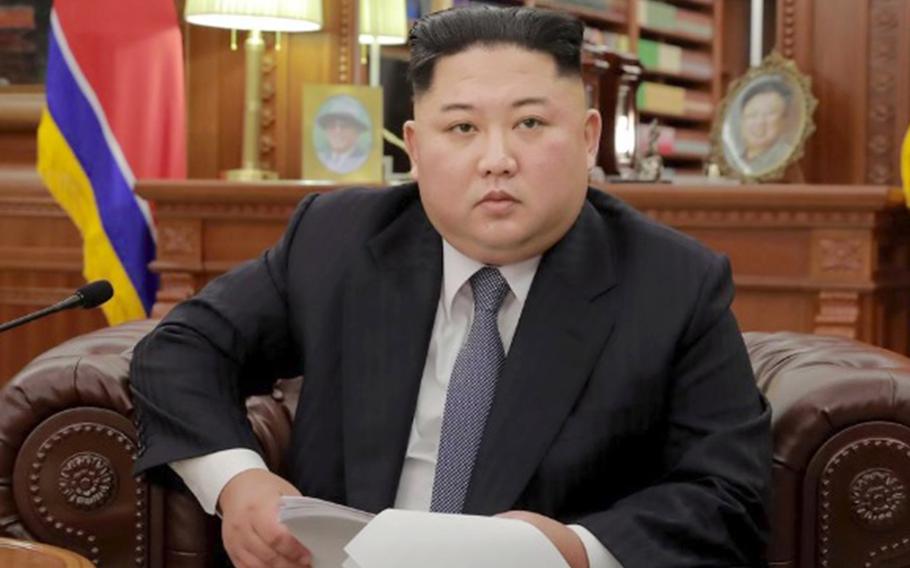
North Korean leader Kim Jong Un poses for a photo released in January 2019 by the Korean Central News Agency. (Via KCNA)
SEOUL, South Korea — North Korea test-fired two short-range ballistic missiles off its eastern coast Wednesday for the second time in just under a week, South Korea’s military said, casting a shadow over hopes that nuclear talks may resume soon.
The launch raises pressure on the United States as it tries to restart talks aimed at persuading the North to abandon its nuclear weapons. North Korea is likely angling to increase its leverage in negotiations while expressing anger over planned joint U.S.-South Korean military exercises and continued sanctions, experts said.
The missiles flew about 155 miles from the town of Wonsan and reached an altitude of less than 20 miles before splashing into the sea, according to the South’s Joint Chiefs of Staff.
The first one was launched at 5:06 a.m. and the second at 5:27 a.m., it said, updating its earlier statement that “several projectiles” had been fired.
Military officials said the North launched the missiles from a truck. Their flights were tracked by the South using various intelligence assets, including radar and a destroyer equipped with an Aegis combat system.
“The repeated missile launches by North Korea are not helpful to efforts to ease tensions on the Korean Peninsula and we urge North Korea to stop this behavior,” the South’s Joint Chiefs said.
The South Koreans and the Americans were still analyzing the launch for more details.
The missiles fired Wednesday fell short of Japan’s territorial waters, according to Japan’s Defense Ministry.
“It is extremely regrettable that North Korea continues firing missiles that violate [United Nations] resolutions,” Defense Minister Takeshi Iwaya told reporters.
U.S. Forces Korea, the main command for the 28,500 American troops based in the South, was “aware of the two launches” and was assessing the situation, said spokesman Col. Lee Peters.
Last Thursday, the North fired two short-range ballistic missiles from the same area. South Korean military officials later said they were a new type of weapon similar to Russia’s Iskander.
The Joint Chiefs said those missiles flew more than 370 miles and reached an altitude of 30 miles, which experts said was likely designed to evade U.S. and South Korean defense systems on the divided peninsula.
The North called it a “solemn warning” to South Korea against joining the U.S. in joint military exercises expected to take place next month as well as purchasing more state-of-the-art fighter jets from the United States.
So far, the missile tests have not drawn a strong reaction from President Donald Trump’s administration. The president dismissed concerns about last week’s launches, calling them “smaller missiles” and noting the North didn’t say it was “a warning to the United States.”
Trump insists he maintains a good relationship with North Korean leader Kim Jong Un. The leaders have met three times in just over a year, most recently on June 30 in a surprise encounter on the heavily fortified border that divides the Korean Peninsula.
Last week, a senior U.S. National Security Council staffer hand-delivered photographs from that meeting to a North Korean official, The Associated Press quoted a senior U.S. official as saying.
Secretary of State Mike Pompeo was cautiously optimistic about the chances for resuming working-level talks, which have been deadlocked since a February summit between Trump and Kim ended without agreement in Vietnam.
“We think they’ll be started before too long. I’m very hopeful,” he told reporters en route to Thailand. “Chairman Kim had said when the two leaders met at the DMZ that it could get started in a few weeks. It’s taken a little bit longer than that.”
“There’s been a little bit of preliminary work to be done,” he added.
Pompeo didn’t set a date but said he hoped the special U.S. envoy for North Korea Stephen Biegun would meet with “what I think will be a new counterpart from North Korea.”
New Defense Secretary Mark Esper also was due to travel to Seoul as part of a regional tour beginning Friday.
The launches, along with the firing of two short-range ballistic missiles in early May, have broken a lull in such activity, although short-range missiles wouldn’t technically violate a pledge by Kim to suspend intercontinental ballistic missile and nuclear tests.
Stars and Stripes reporter Yoo Kyong Chang contributed to this report.
gamel.kim@stripes.com Twitter: @kimgamel